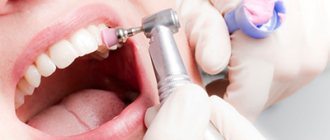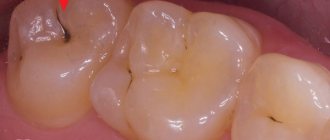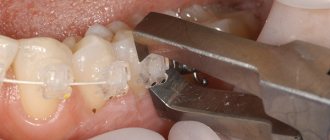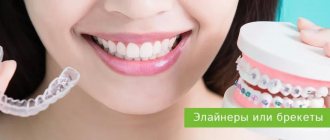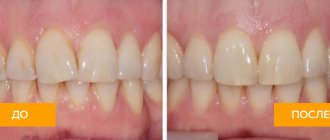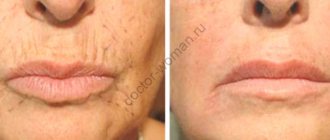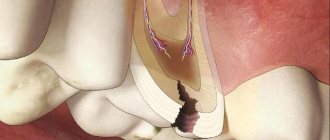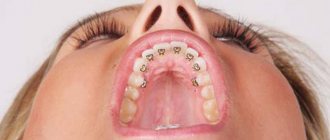If you are reading this article, it means that you are interested in improving your bite and are considering braces.
This shows that you have the determination to achieve a healthy, charming smile.
Here we have collected the questions that people most often write to us in messages.
I hope this changes your life for the better, just like it has changed the lives of thousands of other people.
Can adults get braces to correct their bite?
Anyone can correct a malocclusion, regardless of age. But in an adult, this process takes longer than in children, because skeletal growth has already stopped and hard bones are more difficult to form.
In addition, some oral health conditions may delay the installation of braces. For example, caries, periodontal disease, endocrine diseases.
Sometimes the effect of treatment is influenced by the presence of crowns and bridges. The treatment period starts from 1.5 years.
Types of bracket systems
Installation principle systems are defined as:
- vestibular - the classic form of the device, attached to the outer part, visible,
- lingual - fastening on the internal (lingual) part, not accessible to view from the outside.
The designs are: ligature - the use of elastic bands, replaced with elastic ones as the bite is straightened, and modern non-ligature instruments.
Note! Lingual differs from vestibular not only in the high cost of maintenance, but also not in ease of wearing: a foreign body installed on the inside often wants to be explored with the tongue, which causes injury and affects diction. In addition, an “invisible” device is more difficult to care for.
When choosing a lingual system, you can install braces only from all-metal material; for vestibular installation, there is a wide selection of types of brackets.
Metal braces are standard steel components and a steel ligature, which in the new design have been reduced in size, reducing the inconvenience caused to the user.
Advantages:
- ease of use,
- comfortable care when wearing,
- low price,
- efficiency,
- In the case of ligatures, children and adolescents can choose the color of the rubber bands to determine their individuality.
Flaws:
- noticeable.
Plastic
Plastic braces are designed to correct minor irregularities, as they do not have sufficient strength and cannot affect severe irregularities and curvatures.
Advantages:
- unusual design,
- They are made transparent, making them practically invisible.
Flaws:
- turn yellow and wear out,
- do not have a strong impact, increasing the time period.
Ceramic system
Ceramic braces - made of ceramics matched to the enamel tone to reduce visibility.
Advantages:
- aesthetics,
- By choosing a ceramic tone that is a shade lighter than natural enamel, you get a whitening effect.
Flaws:
- are more expensive
- more time is spent on care.
Sapphire braces
The sapphire braces system is characterized by being made from artificially grown sapphires, which, due to the refraction of light, become transparent on a dazzling smile.
Advantages: not visible to outsiders.
Flaws:
- impressive price,
- exclusion of any products that can damage the components (nuts, snacks, hard vegetables and fruits).
Titanium
Titanium braces are a metal type, the main material of which the device is made is titanium.
Advantages:
- hypoallergenic,
- strong and durable, suitable for changing “neglected” cases.
Disadvantages: noticeable to prying eyes.
The dentist may suggest installing a combined design of braces: ceramics on the front ones, and a classic prefabricated metal bracket system on the “invisible” rear ones.
How does this happen?
You need to start working on correcting the curvature with an individual consultation with a specialist. During the appointment, the doctor assesses the condition of the oral cavity through examination, x-rays, taking impressions, and selects the best braces to correct the situation.
The most informative is a 3D image of the cavity, offered by most modern reputable clinics. This diagnostic method will be more expensive, but it is the most accurate for determining the scope of work.
Next comes oral debridement:
- detection of caries disease,
- treatment of caries in fact,
- thorough hygienic cleaning,
- in the absence of support for fixation, the issue of future implantation is decided.
Installation of braces (one row per visit) lasts about 2 hours, depending on the complexity of the case: the specialist prepares the surface, installs the bracket and attaches the arch to them. The procedure is absolutely painless.
Correction is necessary every 1-1.5 months until the problem is completely eliminated:
- metal - 1-2 years,
- ceramic and sapphire - up to two years,
- lingual - 1-2 years.
Removing braces involves opening the “locks” of the system, removing the thick fishing line and removing the “squares” with special tweezers. Next, the doctor will install a retainer (steel wire) on the inner surface of the teeth, or offer a transparent plastic tray to secure the achieved result. The retention device will remain with the patient for at least a year. After removal, the doctor polishes the enamel and coats it with fluoride (varnish or paste).
What is the price
The answer to the question of how much braces cost can only be given by determining the factors that influence the cost:
- The degree of complexity of the initial problems, the number of crooked teeth,
- the straightening method chosen by the patient (metal is cheaper than sapphire and ceramics, internal is more expensive than external),
- material of components,
- availability and preparedness (a template version may be suitable for the user, or custom-made may be necessary),
- brand (domestic or foreign)
- the need for preparatory work (getting rid of carious stains, pulpitis, placing a temporary crown).
Don’t forget about a monthly visit to the orthodontist for arch correction and oral hygiene. The final cost is the sum of the drawn up treatment plan and is necessarily specified in the contract or agreement, as well as the method of payment (immediately or in installments).
On average, taking into account all factors, the average price for titanium devices is from 80 to 150 thousand rubles per jaw, sapphire ones will cost from 100 to 250. Lingual brace - up to 300 thousand rubles.
The choice of suitable structures depends on the knowledge and skills of the orthodontist, patient reviews, and before and after photos.
You should not skimp on your bite when the bones of the jaw and skull are involved, affecting the overall health of a person. Choose professional dentistry carefully and do not chase promotions and unprecedented prices.
Does teeth straightening hurt?
The installation of braces itself is painless, but requires patience because it takes about an hour.
For 7-10 days, teeth may hurt when biting. The body must get used to foreign objects. In general, you live your old life, you just notice pleasant changes in yourself.
Control visits are needed to correct the process and form the correct position of the teeth. Usually after changing the arch the pain goes away within 3-7 days. It all depends on individual sensitivity.
For some, wearing braces is only unpleasant, for others, on the contrary, it is painful, and some do not feel anything.
Causes of problems
Negative consequences of braces most often occur when medical recommendations are not followed, namely:
- poor oral hygiene;
- consumption of foods that are undesirable during treatment with braces;
- non-compliance with other medical recommendations (they are individual for each patient).
Problems when wearing braces can also arise due to weakened immunity and some individual characteristics of the body. It is important to consult a doctor in a timely manner to eliminate current disorders. Before installing the structure, the doctor weighs all the pros and cons of such treatment, taking into account the patient’s characteristics.
Do braces make it difficult to eat?
Once installed, you will need to learn how to eat in them. This period takes on average 3-7 days.
At this time, give preference to soft and liquid foods. Cut fruits and vegetables into small pieces. Avoid fibrous and sticky foods.
Over time, you will be able to eat almost everything except Coca-Cola (can dissolve glue), hard foods (nuts, crackers, chocolate) and sticky sweets (chocolate, cookies or caramel bars). You should also not chew gum.
Aesthetics
If you are unsure whether braces are right for you, consider that correcting misalignments and bites is not only about beauty, but also about the health of your teeth for life. This is truly a treatment, not a fad, and the sight of orthodontic systems on teeth has not bothered anyone for a long time. In fact, anyone who sees you with braces will remember their problems, wish they had gotten them, or praise you for taking care of your health.
And most importantly, imagine your beautiful smile, what it will look like at the end of treatment. When you finally get your braces removed, professional cleaning or whitening done, you will see what all these difficulties and efforts were for. Even the need to wear retainers or a mouth guard for some time after the systems are removed is worth it to enjoy your straight and beautiful teeth and smile easily and happily to the whole world. Finish what you started and be healthy!
Return to list of articles
How often should inspections be carried out?
Every 1-2 months, it all depends on the defect and the individual structure of the patient’s teeth. During the visit, the orthodontist checks the success of the treatment and sets a vector for the arch, which determines the movement of teeth in the right direction.
Missing follow-up visits may negate the effect of previous treatment. You are also required to visit a hygienist every six months.
Braces, whether external or internal, need to be worn for an average of 1.5 years. But determining more precise timing depends on the initial situation and age of the patient. Sometimes it takes 2 years to eliminate a defect.
Installation of veneers
Veneers are porcelain or composite plates that replace the outer thin layer of a tooth.
Effectively correct dental discoloration, cover cracks or stains due to enamel hypoplasia. Veneers are an aesthetic solution and do not replace orthodontic treatment. Unlike veneers, braces move teeth. Treatment with braces ensures the formation of an aesthetically correct smile, restoration of the physiological bite and function of the dental system. The material is for informational purposes only and is presented for informational purposes. It does not replace consultation with an orthodontist and is not a guide to correcting dental anomalies.
What to do if the bracket comes off?
In itself, this happens quite rarely, only in cases of severe crowding of teeth, since the arch puts a lot of pressure on the dentition and the lock falls off. Another option is if the patient is a nut or other solid food lover.
If you find a broken bracket, contact your orthodontist immediately. Otherwise, the teeth will begin to gradually move to their original position. Also remove elastic bands if you wear them.
The doctor sees patients with unstuck braces out of turn. It takes about 5 minutes to glue a new lock.
It also happens that the archwire flies out of the bracket grooves. You can try to get it back yourself. However, this should be done extremely carefully, without damaging the adjacent locks.
Features of proper care
To prevent teeth from deteriorating after braces, it is important to follow basic oral care rules. These are 3 key recommendations:
- Proper hygiene . If you have braces, then from now on you won’t be able to get by with just a toothbrush. In addition, special brushes, small brushes, dental floss and mouthwash are also used. It is also advisable to use an irrigator to wash the oral cavity. Such hygiene is necessary to prevent caries, so that teeth do not deteriorate.
- Power control . Braces are a fairly fragile structure that can be damaged by hard foods, such as nuts, crackers, hard cheese and others. Avoid such foods, as well as sticky foods. If a breakdown or deformation of structural elements suddenly occurs, you should consult a doctor as soon as possible. It is contraindicated to remove braces on your own.
- Examinations with a doctor . In addition to the emergency cases described above, you also need to regularly go to the doctor for preventive examinations. Most often this is once a month, but an individual schedule is drawn up for each patient.
How to brush your teeth with braces?
This is where a traditional toothbrush and toothpaste don't serve their purpose. Therefore, you will need to buy a special orthodontic brush, brushes and floss from the pharmacy. You can also use an oral irrigator if you wish.
This way you can effectively clean your teeth and the area around the locks. Teeth should be thoroughly brushed after each meal, because food debris is deposited on braces, which contributes to the development of caries and does not look aesthetically pleasing. We have repeatedly encountered patients whose teeth are more well-groomed than those of a person without braces.
Can braces not help?
Wearing the system gives excellent results. If the dental units begin to diverge again, it means the patient did something wrong. Perhaps the doctor made mistakes at the diagnostic stage.
After therapy, wearing retainers (guards) is indicated. If this is not done, the incisors, canines and molars will quickly return to their previous position.
An important factor is the experience and professionalism of the orthodontist. If there is no positive effect, it is better to change the treating specialist. There are other reasons:
- unsuitable arc type;
- anatomical features of the structure of teeth;
- insufficient period of intervention.
What to do if braces don't help
Having discovered that wearing the structure turned out to be ineffective, you must first understand why this happened. When the system is dismantled, and the patient does not wear retainers (mouthguards) due to damage, loss, or does not even know that this should have been done, it is worth contacting the treating orthodontist. He will select the appropriate accessory. However, this applies to cases when no more than 2-3 days have passed since the removal of the structure. If a longer period has passed, the staples are reinstalled. The re-treatment will take less time than the first time, but it will last until the rows are aligned again.
If the doctor’s qualifications are weak, it is better to turn to another. Tactics depend on the factors that led to the problem.
Are braces the last stage of orthodontic treatment?
After removing braces, you need to consolidate the effect of straightening your teeth. For this purpose, retainers are made that will protect teeth from returning to their original place.
There are two types of retainers:
- Removable – transparent, plastic mouth guards. Used only at night or during a certain period.
- Non-removable - made of metal. They are installed on the back surface of the teeth using special composite materials.
The decision on the best method is made by the orthodontist. The aligners must be worn at all times during the first month, removed only for eating and brushing your teeth. On average they are worn for 2 years.
While wearing retention devices, you must visit a doctor every 3-6 months.
Restoring enamel after braces
The aesthetic consequences of braces can be successfully eliminated using the following procedures:
- professional cleaning;
- teeth whitening;
- installation of retainers with a special composition that strengthens the enamel;
- polishing and processing of enamel with special solutions.
Can you continue to live with crooked teeth?
Crooked teeth are more vulnerable to tooth decay and periodontal disease. If teeth grow incorrectly, their surfaces become excessively worn down when eating, which worsens the malocclusion. Therefore, sometimes it leads to serious diseases of the temporomandibular joints.
In addition, if you suffer from frequent headaches, chondrosis, or have tinnitus, it is better to check your bite.
Content:
- The consequences of braces that a person faces while wearing them
- Consequences of braces after removal
- Why problems arise
- How to make treatment as comfortable as possible
Most people are only aware of the positive effects of braces .
They are convinced that after using leveling devices, the bite becomes normal, the smile takes on a more beautiful appearance, and the patient gets a Hollywood smile. But not everyone knows that wearing braces is associated with various risks and very often leads to complications. In this article we will talk about the negative consequences of braces. All people planning orthodontic treatment should be aware of them. Being informed will save you from many problems and disappointments.
Braces hurt the oral cavity, what should I do?
After installing braces, each patient receives wax for locks from the orthodontist. At the very beginning, it is worth applying it to the entire system, because the mucous membrane in the oral cavity is not yet accustomed to contact with foreign objects.
Abrasions and wounds heal very quickly. Their healing can be accelerated by using agents that promote the healing of wounds in the oral cavity.
When you can and cannot wear braces
The use of the system is indicated for malocclusion, crowding, and diastema. People of any age can be treated in this way. There are some restrictions for pregnant women, patients with implants, etc.
Who is contraindicated for installing arches:
- persons with acute immunological and neuropsychiatric diseases;
- patients with diseases associated with blood clotting;
- people with bruxism, serious gum pathologies;
- if you are allergic to metal or other materials used.
